YAMAHA MAJESTY 250 2003 Owners Manual
Manufacturer: YAMAHA, Model Year: 2003, Model line: MAJESTY 250, Model: YAMAHA MAJESTY 250 2003Pages: 116, PDF Size: 2.07 MB
Page 91 of 116
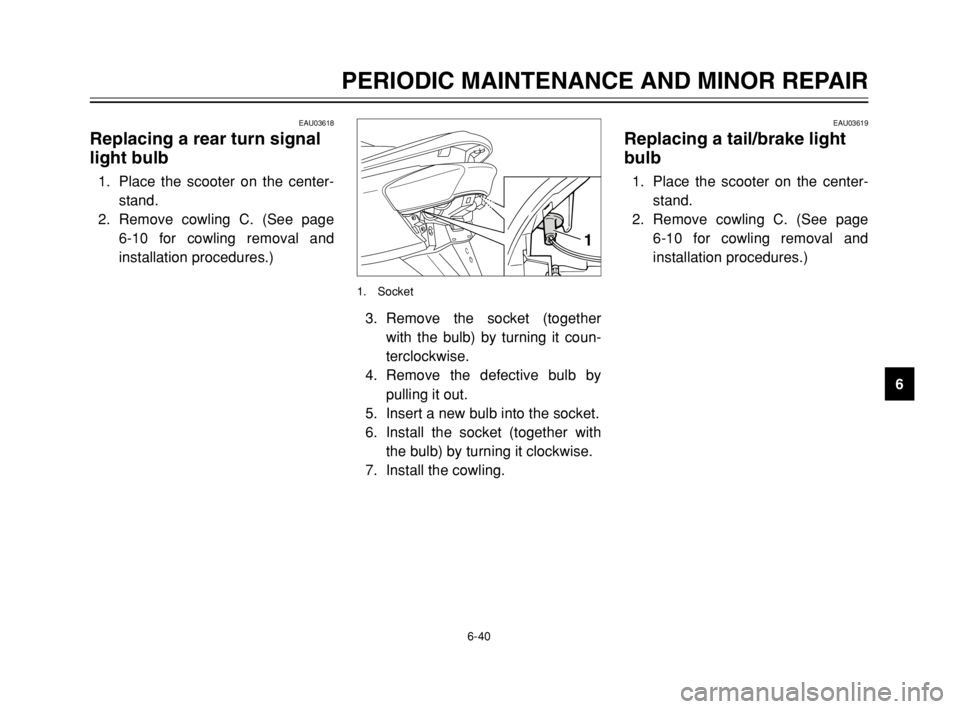
6-40
PERIODIC MAINTENANCE AND MINOR REPAIR
6
EAU03618
Replacing a rear turn signal
light bulb
Turn signal light bulb (rear), replacing1. Place the scooter on the center-
stand.
2. Remove cowling C. (See page
6-10 for cowling removal and
installation procedures.)
EAU03619
Replacing a tail/brake light
bulb
Tail/brake light bulb, replacing1. Place the scooter on the center-
stand.
2. Remove cowling C. (See page
6-10 for cowling removal and
installation procedures.)
3. Remove the socket (together
with the bulb) by turning it coun-
terclockwise.
4. Remove the defective bulb by
pulling it out.
5. Insert a new bulb into the socket.
6. Install the socket (together with
the bulb) by turning it clockwise.
7. Install the cowling.
1
1. Socket
5SJ-28199-E1 7/11/02 11:03 AM Page 89
Page 92 of 116
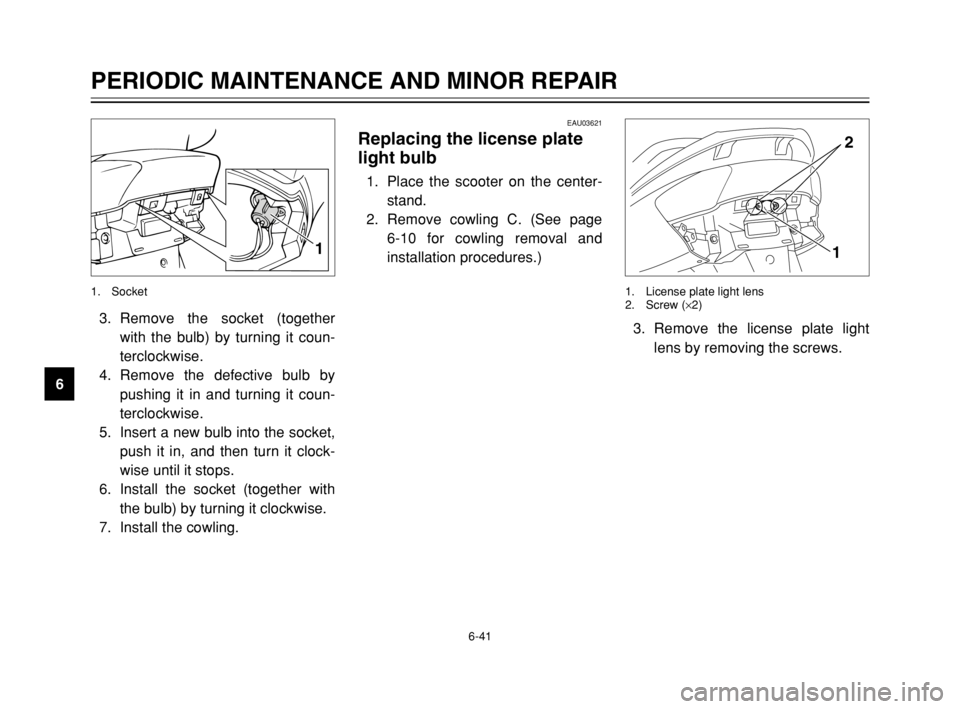
6-41
PERIODIC MAINTENANCE AND MINOR REPAIR
63. Remove the socket (together
with the bulb) by turning it coun-
terclockwise.
4. Remove the defective bulb by
pushing it in and turning it coun-
terclockwise.
5. Insert a new bulb into the socket,
push it in, and then turn it clock-
wise until it stops.
6. Install the socket (together with
the bulb) by turning it clockwise.
7. Install the cowling.
1
1. Socket
3. Remove the license plate light
lens by removing the screws.
12
1. License plate light lens
2. Screw (×2)
EAU03621
Replacing the license plate
light bulb
License plate light bulb, replacing1. Place the scooter on the center-
stand.
2. Remove cowling C. (See page
6-10 for cowling removal and
installation procedures.)
5SJ-28199-E1 7/11/02 11:03 AM Page 90
Page 93 of 116
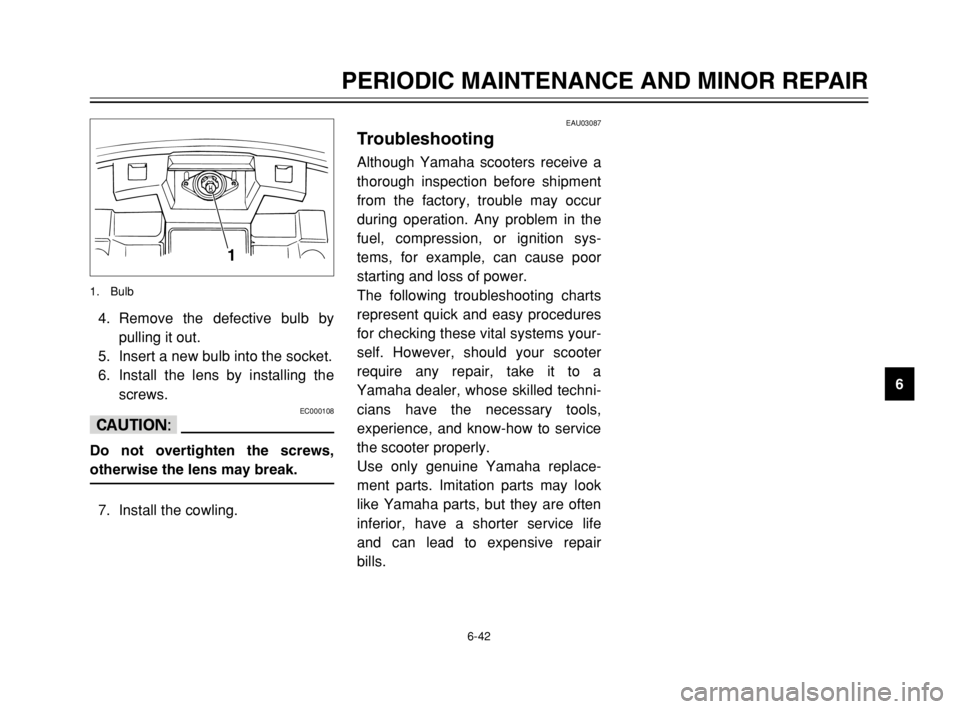
6-42
PERIODIC MAINTENANCE AND MINOR REPAIR
6 4. Remove the defective bulb by
pulling it out.
5. Insert a new bulb into the socket.
6. Install the lens by installing the
screws.
EC000108
cC
Do not overtighten the screws,
otherwise the lens may break.
7. Install the cowling.
1
1. Bulb
EAU03087
TroubleshootingTroubleshootingAlthough Yamaha scooters receive a
thorough inspection before shipment
from the factory, trouble may occur
during operation. Any problem in the
fuel, compression, or ignition sys-
tems, for example, can cause poor
starting and loss of power.
The following troubleshooting charts
represent quick and easy procedures
for checking these vital systems your-
self. However, should your scooter
require any repair, take it to a
Yamaha dealer, whose skilled techni-
cians have the necessary tools,
experience, and know-how to service
the scooter properly.
Use only genuine Yamaha replace-
ment parts. Imitation parts may look
like Yamaha parts, but they are often
inferior, have a shorter service life
and can lead to expensive repair
bills.
5SJ-28199-E1 7/11/02 11:03 AM Page 91
Page 94 of 116
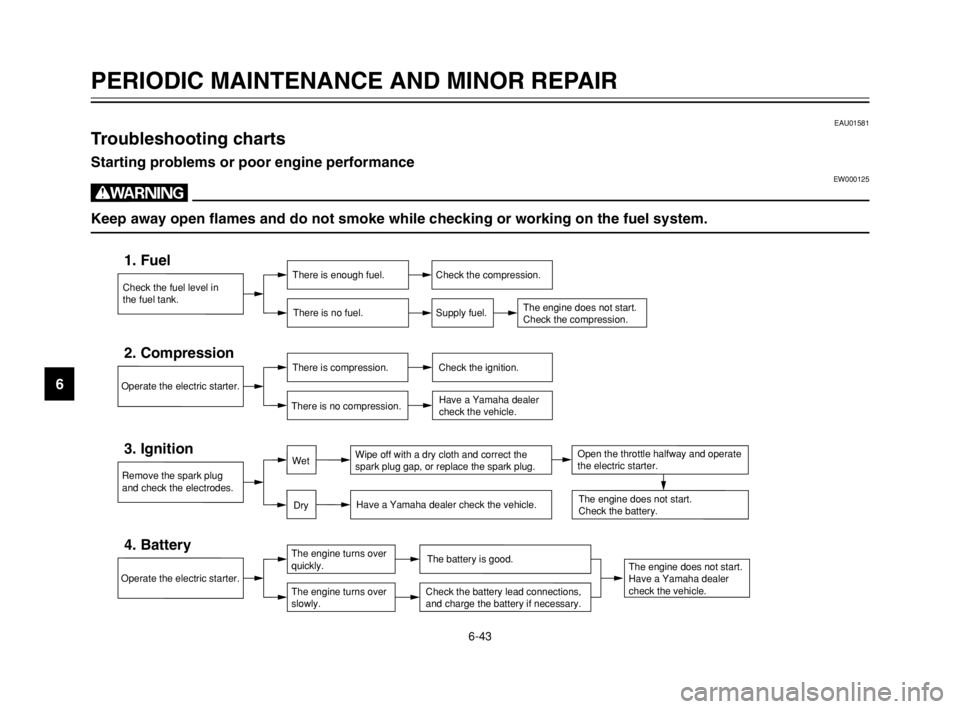
6-43
PERIODIC MAINTENANCE AND MINOR REPAIR
6
EAU01581
Troubleshooting chartsTroubleshooting chartsStarting problems or poor engine performanceEW000125
w
Keep away open flames and do not smoke while checking or working on the fuel system.
Check the fuel level in
the fuel tank.
1. FuelThere is enough fuel.
There is no fuel.Check the compression.
Supply fuel.
The engine does not start.
Check the compression.
Operate the electric starter.
2. CompressionThere is compression.
There is no compression.Check the ignition.
Have a Yamaha dealer
check the vehicle.
Remove the spark plug
and check the electrodes.
3. IgnitionWipe off with a dry cloth and correct the
spark plug gap, or replace the spark plug.
Have a Yamaha dealer check the vehicle.
The engine does not start.
Have a Yamaha dealer
check the vehicle.
The engine does not start.
Check the battery.
Operate the electric starter.
4. BatteryThe engine turns over
quickly.
The engine turns over
slowly.The battery is good.
Check the battery lead connections,
and charge the battery if necessary.
Dry
WetOpen the throttle halfway and operate
the electric starter.
5SJ-28199-E1 7/11/02 11:03 AM Page 92
Page 95 of 116
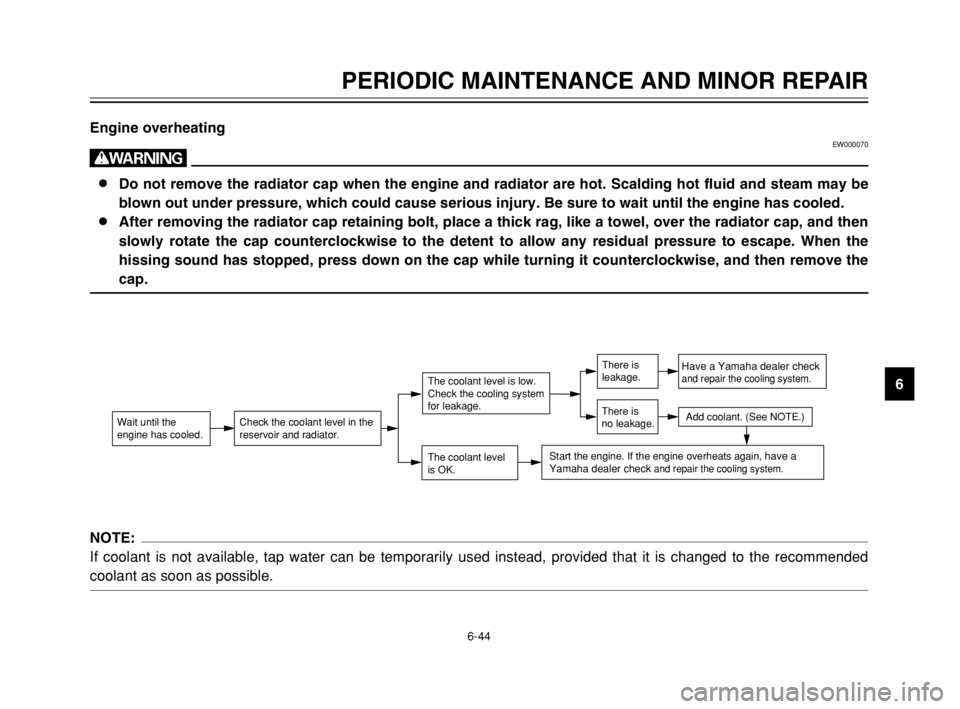
6-44
PERIODIC MAINTENANCE AND MINOR REPAIR
6 Engine overheating
EW000070
w
8 8
Do not remove the radiator cap when the engine and radiator are hot. Scalding hot fluid and steam may be
blown out under pressure, which could cause serious injury. Be sure to wait until the engine has cooled.
8 8
After removing the radiator cap retaining bolt, place a thick rag, like a towel, over the radiator cap, and then
slowly rotate the cap counterclockwise to the detent to allow any residual pressure to escape. When the
hissing sound has stopped, press down on the cap while turning it counterclockwise, and then remove the
cap.
NOTE:
If coolant is not available, tap water can be temporarily used instead, provided that it is changed to the recommended
coolant as soon as possible.
Wait until the
engine has cooled.Check the coolant level in the
reservoir and radiator.
The coolant level
is OK.
The coolant level is low.
Check the cooling system
for leakage.
Have a Yamaha dealer checkand repair the cooling system.
Add coolant. (See NOTE.)
Start the engine. If the engine overheats again, have a
Yamaha dealer check and repair the cooling system.
There is
leakage.
There is
no leakage.
5SJ-28199-E1 7/11/02 11:03 AM Page 93
Page 96 of 116

5SJ-28199-E1 7/11/02 11:03 AM Page 94
Page 97 of 116
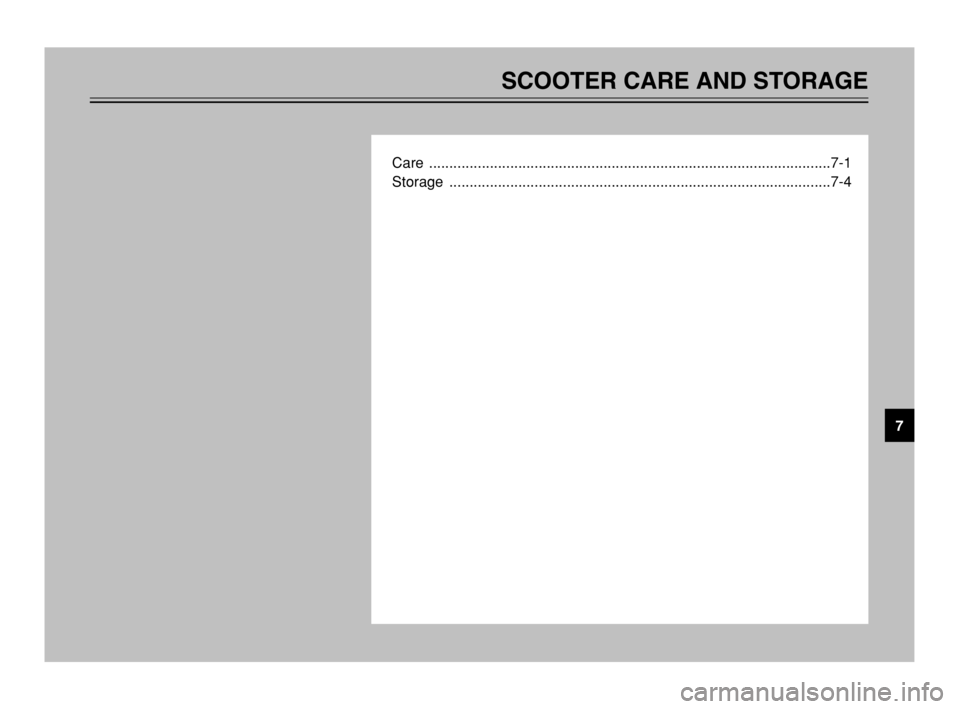
SCOOTER CARE AND STORAGE
Care ...................................................................................................7-1
Storage ..............................................................................................7-4
7
5SJ-28199-E1 7/11/02 11:03 AM Page 95
Page 98 of 116
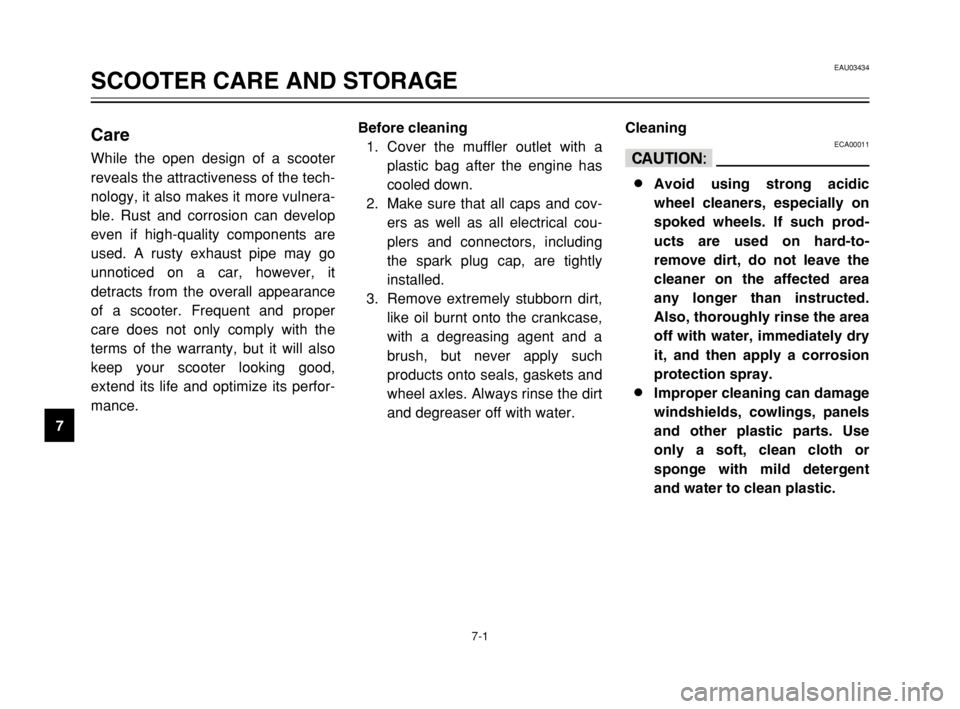
7-1
EAU03434
SCOOTER CARE AND STORAGE
7
CareCareWhile the open design of a scooter
reveals the attractiveness of the tech-
nology, it also makes it more vulnera-
ble. Rust and corrosion can develop
even if high-quality components are
used. A rusty exhaust pipe may go
unnoticed on a car, however, it
detracts from the overall appearance
of a scooter. Frequent and proper
care does not only comply with the
terms of the warranty, but it will also
keep your scooter looking good,
extend its life and optimize its perfor-
mance.Before cleaning
1. Cover the muffler outlet with a
plastic bag after the engine has
cooled down.
2. Make sure that all caps and cov-
ers as well as all electrical cou-
plers and connectors, including
the spark plug cap, are tightly
installed.
3. Remove extremely stubborn dirt,
like oil burnt onto the crankcase,
with a degreasing agent and a
brush, but never apply such
products onto seals, gaskets and
wheel axles. Always rinse the dirt
and degreaser off with water.Cleaning
ECA00011
cC
8
8
Avoid using strong acidic
wheel cleaners, especially on
spoked wheels. If such prod-
ucts are used on hard-to-
remove dirt, do not leave the
cleaner on the affected area
any longer than instructed.
Also, thoroughly rinse the area
off with water, immediately dry
it, and then apply a corrosion
protection spray.
8 8
Improper cleaning can damage
windshields, cowlings, panels
and other plastic parts. Use
only a soft, clean cloth or
sponge with mild detergent
and water to clean plastic.
5SJ-28199-E1 7/11/02 11:03 AM Page 96
Page 99 of 116
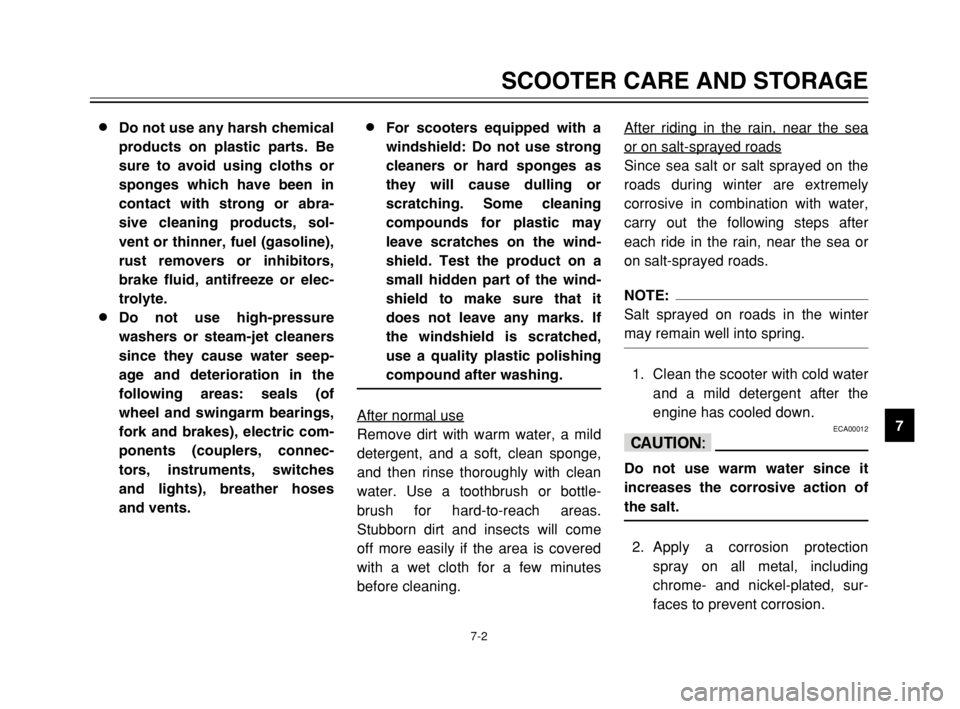
7-2
SCOOTER CARE AND STORAGE
7 8 8
Do not use any harsh chemical
products on plastic parts. Be
sure to avoid using cloths or
sponges which have been in
contact with strong or abra-
sive cleaning products, sol-
vent or thinner, fuel (gasoline),
rust removers or inhibitors,
brake fluid, antifreeze or elec-
trolyte.
8 8
Do not use high-pressure
washers or steam-jet cleaners
since they cause water seep-
age and deterioration in the
following areas: seals (of
wheel and swingarm bearings,
fork and brakes), electric com-
ponents (couplers, connec-
tors, instruments, switches
and lights), breather hoses
and vents.8 8
For scooters equipped with a
windshield: Do not use strong
cleaners or hard sponges as
they will cause dulling or
scratching. Some cleaning
compounds for plastic may
leave scratches on the wind-
shield. Test the product on a
small hidden part of the wind-
shield to make sure that it
does not leave any marks. If
the windshield is scratched,
use a quality plastic polishing
compound after washing.After normal use
Remove dirt with warm water, a mild
detergent, and a soft, clean sponge,
and then rinse thoroughly with clean
water. Use a toothbrush or bottle-
brush for hard-to-reach areas.
Stubborn dirt and insects will come
off more easily if the area is covered
with a wet cloth for a few minutes
before cleaning.After riding in the rain, near the sea
or on salt-sprayed roads
Since sea salt or salt sprayed on the
roads during winter are extremely
corrosive in combination with water,
carry out the following steps after
each ride in the rain, near the sea or
on salt-sprayed roads.
NOTE:
Salt sprayed on roads in the winter
may remain well into spring.
1. Clean the scooter with cold water
and a mild detergent after the
engine has cooled down.
ECA00012
cC
Do not use warm water since it
increases the corrosive action of
the salt.
2. Apply a corrosion protection
spray on all metal, including
chrome- and nickel-plated, sur-
faces to prevent corrosion.
5SJ-28199-E1 7/11/02 11:03 AM Page 97
Page 100 of 116

7-3
SCOOTER CARE AND STORAGE
7After cleaning
1. Dry the scooter with a chamois
or an absorbing cloth.
2. Use a chrome polish to shine
chrome, aluminum and stainless-
steel parts, including the exhaust
system. (Even the thermally
induced discoloring of stainless-
steel exhaust systems can be
removed through polishing.)
3. To prevent corrosion, it is recom-
mended to apply a corrosion pro-
tection spray on all metal, includ-
ing chrome- and nickel-plated,
surfaces.
4. Use spray oil as a universal
cleaner to remove any remaining
dirt.
5. Touch up minor paint damage
caused by stones, etc.6. Wax all painted surfaces.
7. Let the scooter dry completely
before storing or covering it.
EWA00002
w
8 8
Make sure that there is no oil
or wax on the brakes or tires.
If necessary, clean the brake
discs and brake linings with a
regular brake disc cleaner or
acetone, and wash the tires
with warm water and a mild
detergent.
8 8
Before operating the scooter
test its braking performance
and cornering behavior.
ECA00013
cC
8
8
Apply spray oil and wax spar-
ingly and make sure to wipe
off any excess.
8 8
Never apply oil or wax to any
rubber and plastic parts, but
treat them with a suitable care
product.
8 8
Avoid using abrasive polish-
ing compounds as they will
wear away the paint.
NOTE:
Consult a Yamaha dealer for advice
on what products to use.
5SJ-28199-E1 7/11/02 11:03 AM Page 98